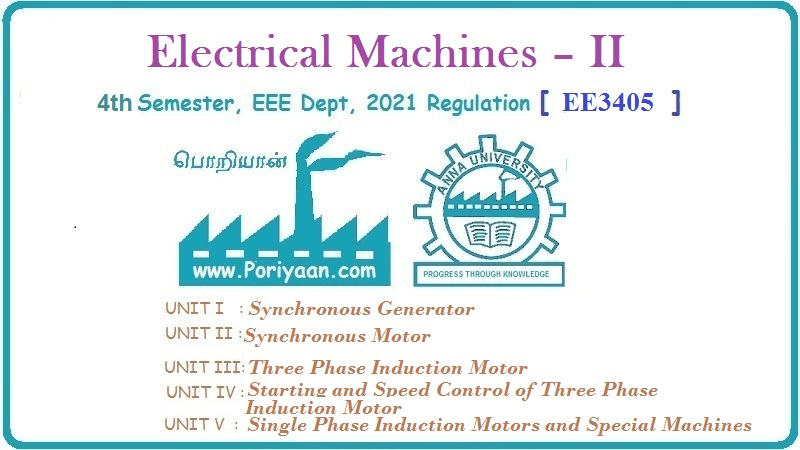Electrical Machines II: UNIT I: a. Synchronous Generator
Harmonics
Synchronous Generator
These sinusoidal components or harmonic functions are called harmonics of the complex wave.
Harmonics
In
case of alternators, the voltage and currents induced are having sinusoidal
waveforms. But practically we can not get sinusoidal waveform when such
alternators are loaded. Due to the loading condition, the generated waveform
deviates from ideal waveform. Such a non sinusoidal waveform is called complex
wave. By Fourier transform this complex waveform can be shown to be built of a
series of sinusoidal waves whose frequencies are integral multiples of the
frequency of fundamental wave. These sinusoidal components or harmonic
functions are called harmonics of the complex wave.
The
fundamental wave is defined as that component which is
having same frequency as that of complex wave. The component which is having
double the frequency of that of fundamental wave called second harmonic. While
the component which is having the frequency three times that of fundamental is
called third harmonic and so on. The complex waveform contains both the even as
well as odd harmonics. Consider a complex wave which is represented by,
e
= E1m sin (wt + ϕ1) + E2m sin (2wt + ϕ2)
+ E E3m sin (2wt + ϕ3 ) … Enm sin (nwt + ϕn)
Where
E1m sin (wt + ϕ1) is fundamental component of maximum value Elm
having an angle ϕ1 from mstrnt of zero of the complex wave.
Similarly Enm sin(nwt + ϕn) represents nth
harmonic of maximum value Enm and having phase angle ϕn
with respect to complex wave.
Out
of foe even and odd harmonics a complex wave containing fundamental component
and even harmonics only is always unsymmetrical about x-axis whereas a complex
wave containing fundamental component and odd harmonics only is always
symmetrical about x-axis. In case of alternators foe voltage generated is
mostly symmetrical as the field system and coils are all symmetrical.
So
foe generated voltage or current will not have any even harmonics in most of
foe cases.
The
complex waveform of voltage can be analysed experimentally by using the
phenomenon of resonance. If voltage waveform containing harmonic content is
applied to the circuit containing resistance, inductance and capacitance, then
the circuit will resonate at one of the harmonic frequencies. The voltage drop
across the resistance can be analysed by using an oscillograph. The values of
inductance and capacitance can be changed so that resonance can be obtained at
fundamental, third harmonic, fifth harmonic etc. The voltage on the
oscillograph indicates the presence of particular harmonics.
1. Slot Harmonics
The
voltage generated in armature windings is derived assuming that the surface of
armature to be smooth. However in practice armature is not smooth but is made
slotted. Due to this slotting certain harmonic e.m.f.s of undesirable order are
produced.
The
reluctance at any point in the air gap depends on whether there is a slot or
teeth in the magnetic path. Since in case of alternators armature is moving,
the teeth and slots alternately occupy positions at this point. This will vary
the reluctance. The ripples will be formed due to variation of reluctance from
point to point in the air gap which is shown in the Fig. 1.13.1.

These
ripples will not move with respect to conductors but glide on the distribution
of flux. The ripples due to slotting of armature are always opposite to slots
and teeth which are causing them. Thus the harmonics which are generated in the
e.m.f. due to slotting is called slot harmonics.
It
can be seen that the main source of harmonics is the non – sinusoidal field
form which can be made sinusoidal and the harmonics can be eliminated.
The
air gap offers maximum reluctance to the flux path. This air gap if made to
vary sinusoidally around the machine, the field form would also be sinusoidal.
Even the air gap is made to vary sinusoidally, the field form can not be
sinusoidal due to saturation in iron parts which is unavoidable. But there
should not be high degree of saturation so that approximately sinusoidal
waveform will be obtained.
Thus
in general it can be seen that ideal sinusoidal field form is very difficult to
obtain whether the machine is salient pole type or cylindrical rotor
construction.
2. Harmonics Minimization
To
eliminate or minimize the harmonics from the voltage waveform, the windings
must be properly designed. The different ways to eliminate the harmonics from
generated voltage are,
i)
Distribution of armature windings : Instead of having
concentrated type of windings, they should be distributed in different slots.
The distribution factor for harmonics is comparatively less than that of the
fundamental and hence magnitude of harmonic e.m.f. is small.
ii)
Chording : The e.m.f. generated in the winding is proportional
to cos (x a /2) where a is angle of chording and x is order of harmonic. If
proper value of angle of chording is selected then harmonic e.m.f.s can be
reduced significantly.
iii)
Fractional slot windings : The output voltage waveform will
be free of harmonics by facilitating the use of fractional slot windings as the
distribution factor will be smaller compared to that with the fundamental.
iv)
Skewing : Skewing the pole face will help in eliminating the
slot harmonics.
v)
Large length of air gap : The reluctance will be increased
by increasing the air gap and slot harmonics can be reduced.
Review Questions
1. What are harmonics ? Explain the slot harmonics.
2. What are the methods used to reduce harmonics in three phase
alternators ? Explain.
Electrical Machines II: UNIT I: a. Synchronous Generator : Tag: Engineering Electrical Machines - II : Synchronous Generator - Harmonics
Related Topics
Related Subjects
Electrical Machines II
EE3405 Machine 2 EM 2 4th Semester EEE Dept | 2021 Regulation | 4th Semester EEE Dept 2021 Regulation
